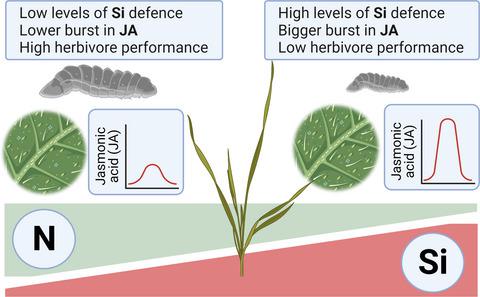Our official English website, www.x-mol.net, welcomes your feedback! (Note: you will need to create a separate account there.)
Siliceous and non-nutritious: Nitrogen limitation increases anti-herbivore silicon defences in a model grass
Journal of Ecology ( IF 5.5 ) Pub Date : 2021-07-29 , DOI: 10.1111/1365-2745.13755 Scott N. Johnson 1 , Jamie M. Waterman 1 , Richard Wuhrer 2 , Rhiannon C. Rowe 1 , Casey R. Hall 1 , Ximena Cibils–Stewart 1, 3
中文翻译:

含硅和无营养:氮限制增加了模型草中的抗食草动物硅防御
更新日期:2021-07-29
Journal of Ecology ( IF 5.5 ) Pub Date : 2021-07-29 , DOI: 10.1111/1365-2745.13755 Scott N. Johnson 1 , Jamie M. Waterman 1 , Richard Wuhrer 2 , Rhiannon C. Rowe 1 , Casey R. Hall 1 , Ximena Cibils–Stewart 1, 3
Affiliation

|
- Silicon (Si) accumulation alleviates a diverse array of environmental stresses in many plants, including conferring physical resistance against insect herbivores. It has been hypothesised that grasses, in particular, utilise ‘low metabolic cost’ Si for structural and defensive roles under nutrient limitation. While carbon (C) concentrations often negatively correlate with Si concentrations, the relationship between nitrogen (N) status and Si is more variable. Moreover, the impacts of N limitation on constitutive physical Si defences (e.g. silica and prickle cells) against herbivores are unknown.
- We determined how N limitation affected Si deposition in the model grass Brachypodium distachyon and how changes in these constitutive defences impacted insect herbivore Helicoverpa armigera growth rates. We used scanning electron microscopy (SEM) and energy dispersive X-ray spectrometry in conjunction with X-ray mapping (XRM) to quantify physical structures on leaves and determine Si deposition patterns. We also determined how N limitation and Si supply impacted the jasmonic acid (JA) pathway, the master regulator of induced defences against arthropod herbivores.
- N limitation reduced shoot growth by over 40%, but increased root mass (+21%), leaf Si concentrations (+50%) and the density of silica (+28%) and flattened prickle (+76%) cells. Energy-dispersive X-ray spectroscopy and XRM established that Si was being deposited in these structures, together with hooked prickle cells and macro-hairs. Herbivore relative growth rates (RGR) were more than 115% lower in Si-supplied plants compared to plants without Si supply and negatively correlated with leaf Si concentration and silica cell density. RGR was further reduced by N limitation and positively correlated with leaf N concentrations. Increases in JA concentrations following induction of the JA pathway were at least doubled by N limitation.
- Synthesis. Si accumulation and deposition were highly regulated by N availability, with N limitation promoting both constitutive Si physical defences and induction of the JA defensive pathway, in line with the resource availability hypothesis. These results indicate that grasses use ‘low-cost Si’ when resources are limited and suggest that plant productivity may benefit from optimising conventional fertilisers and Si fertilisation.
中文翻译:

含硅和无营养:氮限制增加了模型草中的抗食草动物硅防御
- 硅 (Si) 积累减轻了许多植物中的各种环境压力,包括赋予对昆虫食草动物的物理抵抗力。已经假设,特别是草,在营养限制下利用“低代谢成本”Si 来发挥结构和防御作用。虽然碳 (C) 浓度通常与 Si 浓度呈负相关,但氮 (N) 状态与 Si 之间的关系变化更大。此外,氮限制对食草动物的组成性物理硅防御(例如二氧化硅和刺细胞)的影响是未知的。
- 我们确定了 N 限制如何影响模型草Brachypodium distachyon中的 Si 沉积,以及这些本构防御的变化如何影响昆虫食草动物棉铃虫的生长速率。我们使用扫描电子显微镜 (SEM) 和能量色散 X 射线光谱法结合 X 射线映射 (XRM) 来量化叶子上的物理结构并确定 Si 沉积模式。我们还确定了 N 限制和 Si 供应如何影响茉莉酸 (JA) 途径,这是对节肢动物食草动物的诱导防御的主要调节器。
- 氮限制使枝条生长减少了 40% 以上,但增加了根质量 (+21%)、叶硅浓度 (+50%) 和二氧化硅 (+28%) 和扁平刺 (+76%) 细胞的密度。能量色散 X 射线光谱和 XRM 确定 Si 与钩状刺细胞和大毛一起沉积在这些结构中。与没有 Si 供应的植物相比,在 Si 供应的植物中食草动物的相对增长率 (RGR) 低 115% 以上,并且与叶片 Si 浓度和二氧化硅细胞密度呈负相关。氮限制进一步降低了 RGR,并与叶氮浓度呈正相关。JA 途径诱导后 JA 浓度的增加至少因 N 限制而增加了一倍。
- 合成。Si 的积累和沉积受 N 可用性的高度调节,N 限制促进了本构 Si 物理防御和 JA 防御途径的诱导,符合资源可用性假设。这些结果表明,当资源有限时,草使用“低成本的硅”,并表明植物生产力可能受益于优化传统肥料和硅施肥。


























 京公网安备 11010802027423号
京公网安备 11010802027423号